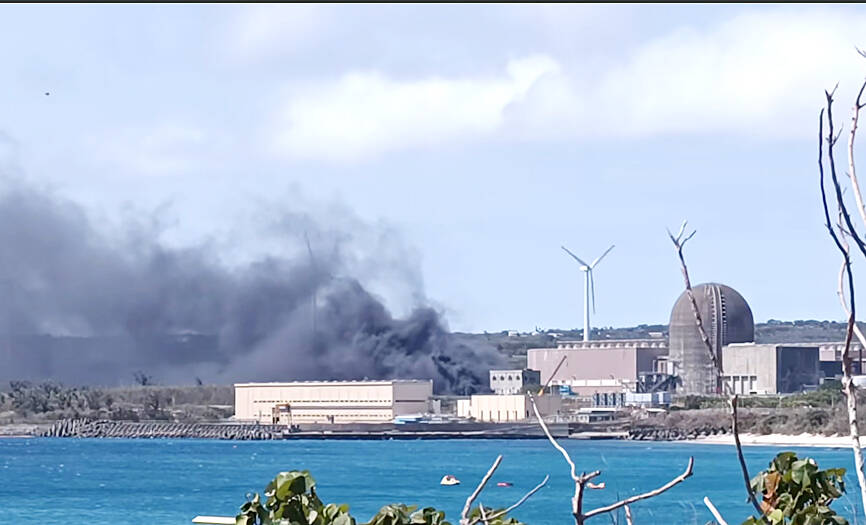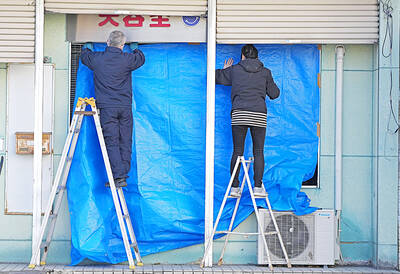A fire that broke out at a nuclear power plant in southern Taiwan yesterday was promptly extinguished and would not cause further safety concerns, the Nuclear Safety Commission said.
A fire broke out yesterday at about 11am at Taiwan Power Co’s (Taipower) Ma-anshan Nuclear Power Plant in Pingtung County’s Hengchun Township (恆春).
At 11:23am, the Pingtung Fire Department received a report that a large amount of black smoke was coming from the plant and sent 12 vehicles and 21 personnel to contain the fire.

Photo: Tsai Tsung-hsien, Taipei Times
By 11:41am, the fire was contained after the plant’s internal fire department used water lines to extinguish the blaze, it said.
No one was injured.
During construction work at the facility, sparks from cutting iron were picked up by the wind and ignited nearby materials, the fire department said.
The building has already been decommissioned, and the fire did not affect power generation or safety, Taipower said in a statement.
Personnel from the commission who were sent to the facility said that there are no concerns about the facility’s safety or radiation leakage.
There have been no changes in radiation conditions in the surrounding area, and the plant continues to function normally, the commission said.
It added that it ordered Taipower to take preventive measures to avoid a recurrence, and vowed to monitor the company’s handling of the situation.
The fire sparked complaints and concern in the vicinity that local authorities were not immediately notified about it.
Hengchun Township Councilor Chao Chi-ming (趙記明) went to the power plant’s front gate to protest what he called a lack of transparency.
Local officials were not permitted entry into the facility.
The plant failed to abide by regulations on reporting such incidents immediately to local officials, the Pingtung County Government said, adding that it would impose the maximum fine allowable under the law.
Violations may be punished with a fine of NT$40,000 to NT$100,000, and the plant might be ordered to suspend operations for up to 30 days.

Taiwanese were praised for their composure after a video filmed by Taiwanese tourists capturing the moment a magnitude 7.5 earthquake struck Japan’s Aomori Prefecture went viral on social media. The video shows a hotel room shaking violently amid Monday’s quake, with objects falling to the ground. Two Taiwanese began filming with their mobile phones, while two others held the sides of a TV to prevent it from falling. When the shaking stopped, the pair calmly took down the TV and laid it flat on a tatami mat, the video shows. The video also captured the group talking about the safety of their companions bathing

US climber Alex Honnold is to attempt to scale Taipei 101 without a rope and harness in a live Netflix special on Jan. 24, the streaming platform announced on Wednesday. Accounting for the time difference, the two-hour broadcast of Honnold’s climb, called Skyscraper Live, is to air on Jan. 23 in the US, Netflix said in a statement. Honnold, 40, was the first person ever to free solo climb the 900m El Capitan rock formation in Yosemite National Park — a feat that was recorded and later made into the 2018 documentary film Free Solo. Netflix previewed Skyscraper Live in October, after videos

Starting on Jan. 1, YouBike riders must have insurance to use the service, and a six-month trial of NT$5 coupons under certain conditions would be implemented to balance bike shortages, a joint statement from transportation departments across Taipei, New Taipei City and Taoyuan announced yesterday. The rental bike system operator said that coupons would be offered to riders to rent bikes from full stations, for riders who take out an electric-assisted bike from a full station, and for riders who return a bike to an empty station. All riders with YouBike accounts are automatically eligible for the program, and each membership account

A classified Pentagon-produced, multiyear assessment — the Overmatch brief — highlighted unreported Chinese capabilities to destroy US military assets and identified US supply chain choke points, painting a disturbing picture of waning US military might, a New York Times editorial published on Monday said. US Secretary of Defense Pete Hegseth’s comments in November last year that “we lose every time” in Pentagon-conducted war games pitting the US against China further highlighted the uncertainty about the US’ capability to intervene in the event of a Chinese invasion of Taiwan. “It shows the Pentagon’s overreliance on expensive, vulnerable weapons as adversaries field cheap, technologically